Digital Therapeutics Statistics: Digital therapeutics (DTx) is indeed gaining popularity as a promising field in healthcare. Digital therapeutics (DTx) is defined as the use of digital technologies.
Such as mobile apps, software programs, and wearable devices – to deliver evidence-based therapeutic interventions for the prevention, management, or treatment of various medical conditions.
These interventions aim to complement or replace traditional treatments by offering more accessible, tailored healthcare that’s both personalized and cost-effective.
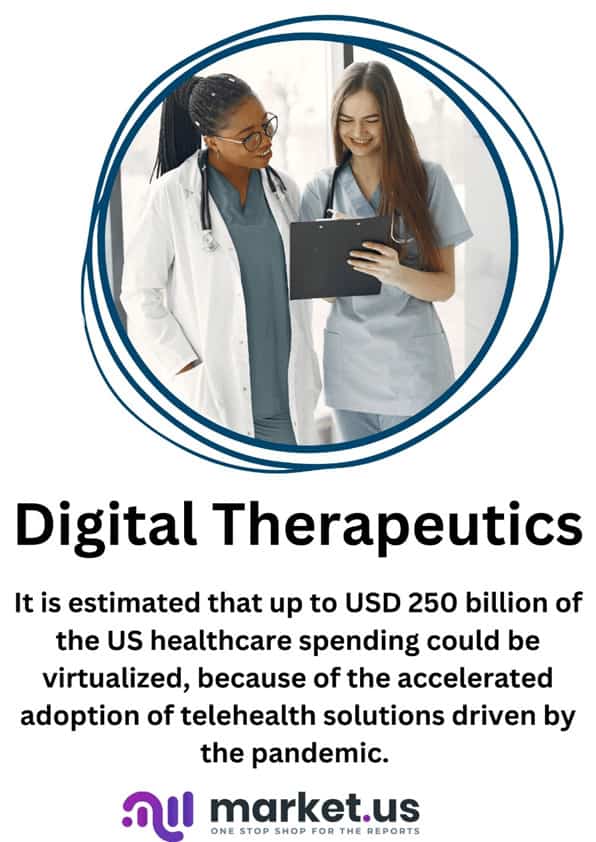
Table of Contents
- Key Digital Therapeutics Statistics
- Global Digital Therapeutics Market, by Application
- Patient Adoption of Digital Therapeutics
- The Potential of Digital Therapeutics
- Cost-Effectiveness and Healthcare Savings
- Investment and Funding
- Key Players in Digital Therapeutics Statistics
- COVID-19 Impact on Digital Therapeutics
- Challenge Statistics in Digital Therapeutics
- Potential Future Applications of Digital Therapeutics
- Recent Developments
- Wrap Up
- FAQs
Key Digital Therapeutics Statistics
- By 2030, the cost of chronic disease management is expected to reach USD 42 trillion.
- the CDC reports that 90% of the US healthcare spend worth USD 3.3 trillion annually goes towards treating people with chronic and mental health conditions.
- Compounding the problem, the global shortage of healthcare workers is also projected to reach 15 million by 2030.
- As medical protocols evolve and care costs decrease, investments in digital therapeutics are expected to surge by 26.7% year over year between 2020-2025. Reaching USD 6.9 billion during that period.
- Today’s market is led by start-ups offering innovative digital therapeutic solutions such as AR/VR-enabled video games that address mental health conditions.
- The COVID-19 pandemic has accelerated the adoption of virtual and home care technologies. Transforming patient engagement by integrating data across the healthcare landscape via wearables and smart devices.
- It is estimated that up to USD 250 billion of the US healthcare spending could be virtualized, because of the accelerated adoption of telehealth solutions driven by the pandemic.
(Source: TCS)
Global Digital Therapeutics Market, by Application
- According to market.us, the global digital therapeutics market was worth USD 4,530 million in 2021. It is expected to grow at a 24.2% CAGR from 2022 to 2032.
- In 2021, the diabetes application segment accounted for more than 28.5% of global revenue.
- The CDC estimates that nearly 34.2 million people will have diabetes in 2023. 10.5% of these people lived in the United States.
- According to the National Centre for Chronic Disease Prevention and Health Promotion, 6 out of 10 Americans have a chronic condition.
- 4 out of 10 people have 2 or more chronic conditions.
(Source: market.us)
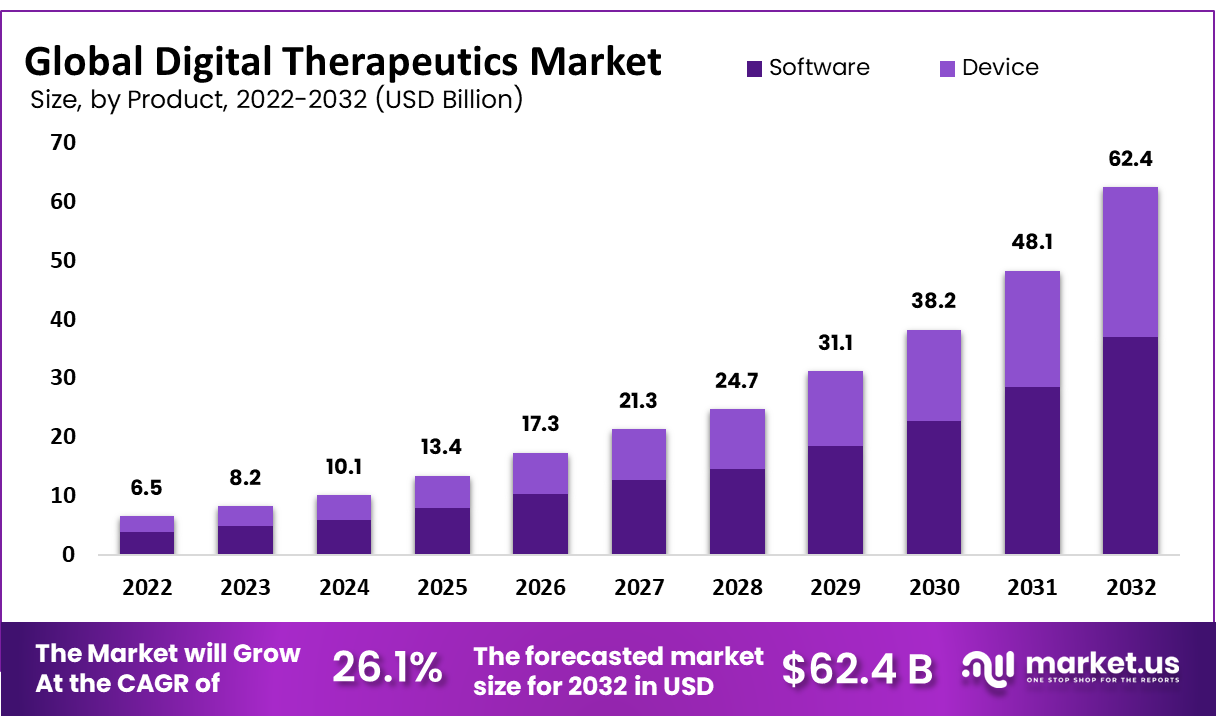
Patient Adoption of Digital Therapeutics
- In 2020, more than 68% of respondents reported that they were interested in using digital therapeutics.
- According to a study published in the Journal of Medical Internet Research, 87% of patients were aware of digital therapeutics, and about 59% of patients were willing to use these services.
- About 86% of patients with chronic diseases were interested in using digital therapeutics. 78% of patients with any chronic condition believed that digital therapeutics could help manage their chronic condition effectively.
- According to a survey conducted by Accenture in 2020, 48% of respondents who had a history of mental health conditions reported using digital mental health tools during the COVID-19 pandemic.
- More than 71% of adults aged 55 years and more are interested in using digital therapeutics.
- About 78% of patients use digital therapeutics for depression, and 83% reported being satisfied with the overall experience.
- In 2021, the number of people using digital therapeutics was reach 44 million. In 2022, the number of digital therapeutics users doubled and reached 90.2 million, and this number is expected to reach 652.4 million by 2025.
(Source: Rock Health, NPJ Digital Medicine, Accenture, Statista)
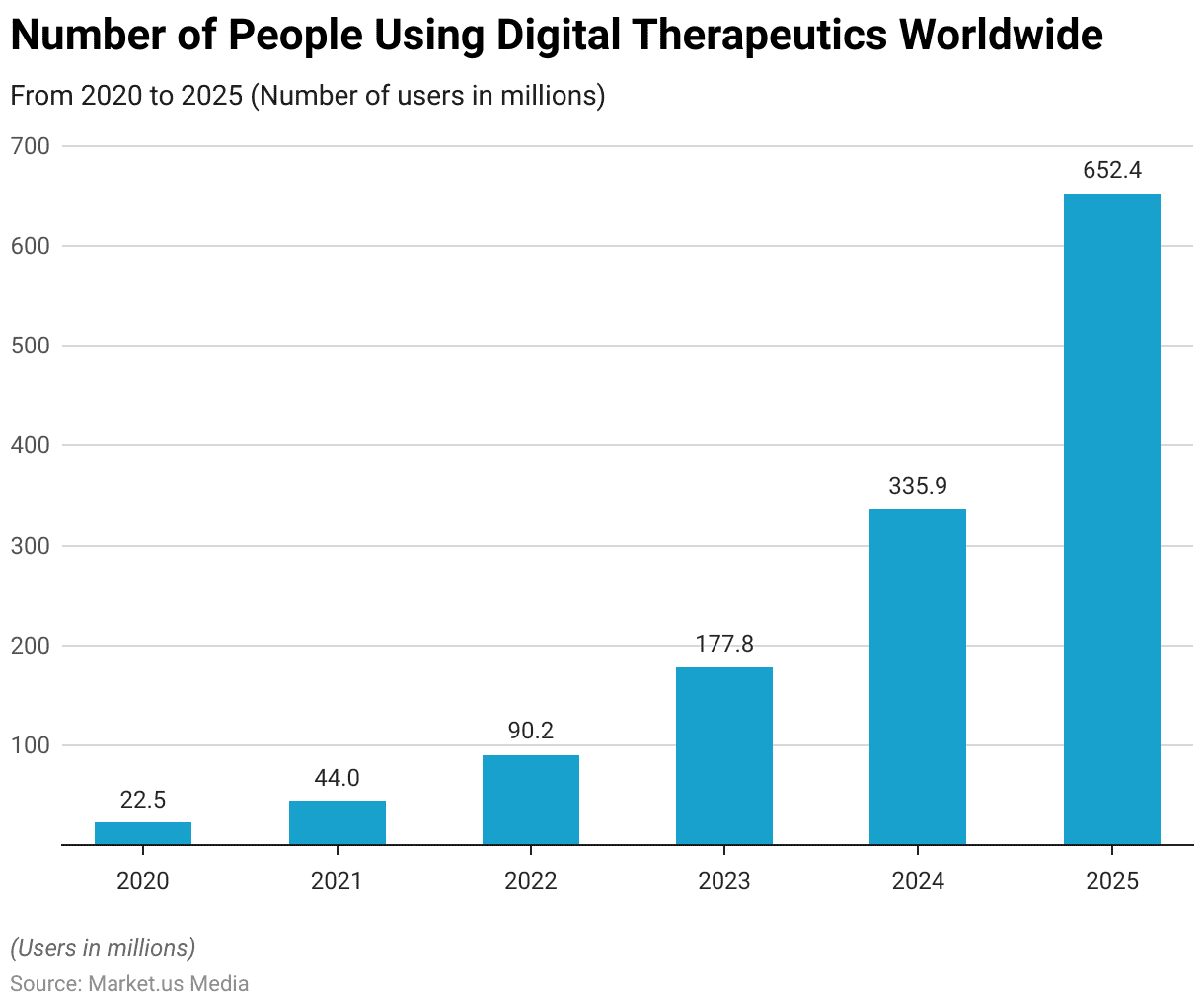
The Potential of Digital Therapeutics
Behavioral Change and Guidance
- Digital therapeutics have shown promising results in helping individuals quit smoking. A study published in the Journal of Medical Internet Research found that a digital therapeutics program for smoking is beneficial in quitting smoking among individuals. After six months, the abstinence rate for the digital therapeutic group was 32.7%, while the rate for the control group was only 14.0%.
- Digital therapeutics play a crucial role in addressing weight management and promoting healthy nutrition habits. The study published in the Journal of Medical Internet Research showed that digital therapeutics interventions focus on behavioral changes and personalized coaching. Which has resulted in significant weight loss among the participants. After six months it was found that the intervention group achieved an average weight loss of 4.59 kg. While the control group had an average weight loss of only 0.25 kg.
- Non-adherence to medication regimens is a common challenge in healthcare. Digital therapeutics offers solutions to improve medication adherence through reminders, educational content, and activity-tracking tools. The study by JAMA Network found that digital interventions significantly help improve medication adherence across a range of conditions such as hypertension, diabetes, and HIV. The pooled analysis of the JAMA Network found that 19% improvement in medication adherence as compared to the control group.
Further
- Digital therapeutics are increasingly utilized to address sleep disorders and improve sleep quality. According to a study published in the Journal of Clinical Sleep Medicine, it is found that digital therapeutics play an important role in improvements in sleep onset latency, total sleep time, and sleep efficiency compared to baseline. The digital therapeutics interventions resulted in a reduction in sleep onset latency by 13 minutes and an increase in sleep onset latency by 28 minutes.
- Digital therapeutics have demonstrated their potential in providing mental health support and guidance. According to a study published in the Journal of Medical Internet Research, digital therapeutics programs help in a significant reduction in depressive symptoms among individuals. A digital therapeutics intervention group experienced a 44% reduction in depression symptoms as compared to a 12% reduction in the control group.
(Source: Journal of Medical Internet Research, JAMA Network Open, Journal of Clinical Sleep Medicine)
Medical Training and Patient Engagement
Recent developments in Virtual Reality (VR) technologies have created significant growth opportunities in the healthcare sector which are beneficial for both patients and physicians. VR technology helps physicians to improve their surgical skills. Also, therapeutic solutions help patients to effectively manage their chronic conditions and receive personalized treatments.
- In recent studies, it was found that 80% of patients felt less pain when they wore a VR headset during surgery, while 73% of patients reported that they felt less anxious when wearing a VR headset during surgery.
(Source: TCS)
Mental Health
Recent technological developments in AI, and advanced analytics. Deep learning allows healthcare providers to closely monitor the symptoms of the behavior of patients.
- About 260 million people worldwide are affected with depression disorder, while about 800,000 people die of suicide worldwide every year.
- In the United States, 1 in 5 young adults have any mental health problem. As compared to this 2/3 of adults do not get the required treatments.
- Mental health disorders are highly prevalent worldwide. According to the World Health Organization (WHO). Approximately 1 in 4 people will experience a mental health condition at some point in their lives.
- The adoption of digital mental health solutions is increasing steadily. According to a survey conducted by the National Council for Behavioural Health in the United States. 66% of healthcare organizations reported using telehealth or telemedicine to provide mental health services during the COVID-19 pandemic.
(Source: TCS)
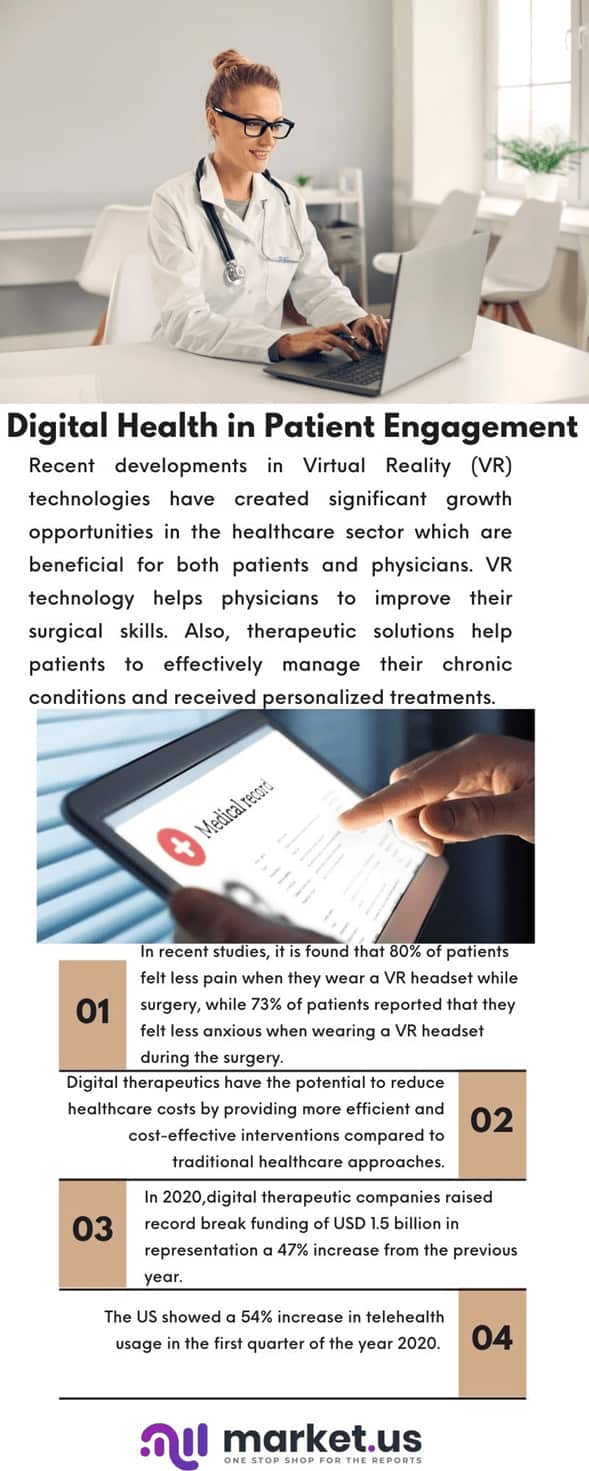
Cost-Effectiveness and Healthcare Savings
- Digital therapeutics have the potential to reduce healthcare costs by providing more efficient and cost-effective interventions compared to traditional healthcare approaches.
- According to a study published in the Journal of Medical Internet Research, digital therapeutics for type 2 diabetes help reduce healthcare costs by USD 339 per patient over six months compared to usual care.
- Digital therapeutics help in reducing hospital visits and emergency room visits. A study published in the Journal of Medical Internet Research demonstrated that heart failure management led to a 52% reduction in hospitalization and a 33% reduction in emergency room visits compared to traditional care services.
- Digital therapeutics can enhance medication adherence, resulting in better health outcomes and cost savings. Digital interventions improve medical adherence by an average of 10-15% across various health conditions.
- According to a report by the Center for Digital Health, digital therapeutics interventions targeting mental health conditions resulted in improved workplace productivity, with an estimated annual economic benefit of $3,000 to $6,000 per employee.
- A cost-effectiveness analysis published in Value in Health demonstrated that digital therapeutics interventions for smoking cessation are cost-effective as compared to standard care, with an incremental cost-effectiveness ratio (ICER) of USD 2,325 per quality life adjusted year (QALY) gained.
(Source: Journal of Medical Internet Research, JAMA Network Open)
Investment and Funding
Investment Trends in Digital Therapeutics Statistics
- In 2020, digital therapeutic companies raised record-breaking funding of USD 1.5 billion in representation a 47% increase from the previous year.
- In 2020, Omada Health raised funding of USD 73 million in series D led by Wellington Management Company.
- Pear Therapeutics raised USD 80 million in a series D funding round led by Softbank Vision Funds in 2021.
- Akili Interactive raised USD 160 million in a series D funding round led by Neuberger Berman Funds in 2021.
- Livongo Health raised USD 355 million in an initial public offering (IPO) in 2029.
(Source: Rock Health)
Key Players in Digital Therapeutics Statistics
Pear Therapeutics
- Pear Therapeutics is a leading digital therapeutics company focusing on developing prescription digital therapeutics (PDTs) to treat various diseases.
- Pear Therapeutics surpassed 14,000 prescriptions for its digital therapeutics in 2021, compared to a forecast of 12,500, and also saw 51% of prescriptions fulfilled.
- The company provides notable products for substance use disorder (SUD) such as reSET and reSET-O.
- The company raised funding of USD 400 million in 2021.
(Source: fierce-biotech)
Akili Interactive
- Akili Interactive is a digital medicine company that develops clinically-validated digital therapeutics for cognitive disorders.
- Akili Interactive has 104 active competitors and it ranks 1st among them.
- The company provides EndeavorRx, a video game-based treatment for children with attention deficit hyperactivity disorder (ADHD).
- The company raised over USD 150 million in funding as of 2021.
(Source: tracxn)
Omada Health
- Omada Health provides digital care programs for chronic diseases, including diabetes, hypertension, and obesity.
- The company provides Clickotine, a digital therapeutic for smoking cessation.
- Omada Health has raised a total funding of $450M over 11 rounds.
- Its latest funding round was a Series E round on Feb 23, 2022, for $192M.
- Omada Health has 43 institutional investors including Fidelity Investments, Andreessen Horowitz, and New Enterprise Associates.
(Source: tracxn)
Livongo (Teladoc Health Inc.)
- Livongo is a digital health company offering a range of remote monitoring and digital therapeutics solutions.
- The company offers Omada for Diabetes, a digital therapeutics program for diabetes management.
- The company raised funding of USD 200 million in 2021.
COVID-19 Impact on Digital Therapeutics

- The COVID-19 pandemic has led to a significant increase in the adoption of telehealth services. According to a report by McKinsey, telehealth usage in the United States increased from 11% of consumers in 2019 to 46% in 2020.
- Mental health is one of the primary areas of telehealth utilization. According to the National Council for Behavioral Health, 66% of healthcare organizations in the United States reported using telehealth or telemedicine to provide mental health services during the pandemic.
- In 2022, the US- 50% and Sweden- 58% had the highest percentage of medical practices that offer online services such as appointments, prescription refills, viewing test results, and viewing visit summaries.
- The US showed a 54% increase in telehealth usage in the first quarter of the year 2020.
- About 2,720 million participants rated telemedicine in the COVID-19 pandemic.
- 70% of medical professionals rated telemedicine in the COVID-19 pandemic.
- Asia Pacific region showed a 52% increase in telehealth access to primary physicians/general patient services from 4% to 56%.
- According to a report by IQVIA, as of 2020, there were over 400,000 mobile health applications available in major app stores. With mental health and chronic disease management being the most common categories.
- A survey conducted by Rock Health found that in the United States. Digital therapeutics were most commonly used by individuals aged 35-44, followed closely by those aged 25-34.
- A study published in JAMA Network Open reported that telehealth visits accounted for 35.3% of primary care providers in the United States in early 2021.
(Source: The Commonwealth Fund-2022, Willis Towers Watson-2022)
Challenge Statistics in Digital Therapeutics
- Regulatory approval processes are complex and time-consuming. More than 55% of digital therapeutics companies identified regulatory approval as a major challenge.
- 66% of digital health companies identified reimbursement as a major barrier to market access.
- About 45% of patients expressed concerns about the privacy and security of their data in digital therapeutics.
- According to the report by Ponemon Institute, the average cost of a healthcare data breach in the United States was USD7.13 million in 2020.
- About 30% of users discontinued the use of digital therapeutics for chronic disease management.
- According to the Digital Therapeutics Statistics: There are still some barriers to the adoption of digital therapeutics. In 2021, the main barriers to the adoption of digital therapeutics include a lack of awareness (25%), skepticism about efficacy (19%), and concerns about data privacy and security (15%).
(Source: Digital Therapeutics Alliance, Rock Health, Deloitte, Journal of Medical Internet Research-JMIR)
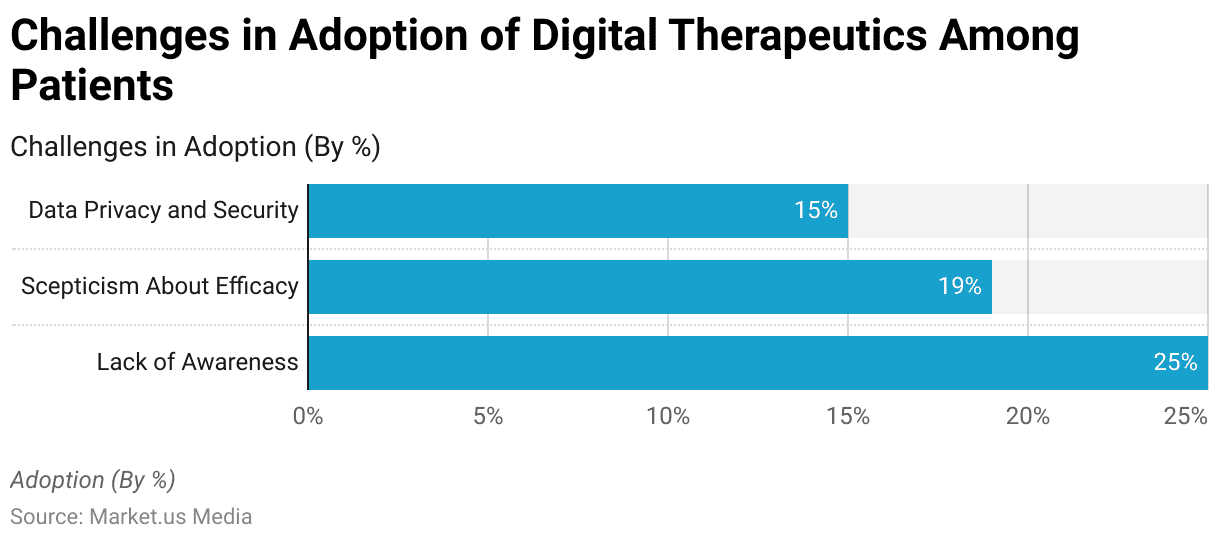
Digital Therapeutics Integration Statistics
- About 76% of healthcare providers in the United States reported incorporating digital therapeutics in their clinical practices.
- According to Digital Therapeutics Statistics: 70% of physicians believed that digital therapeutics would become a part of standard care within the next five years.
- As of 2021, more than 80% of the top 20 pharmaceutical companies have partnered with digital therapeutics companies to develop and commercialize digital therapeutics solutions.
- The COVID-19 pandemic accelerated the demand for telemedicine. About 83% of healthcare providers in the United States use telemedicine for patient care.
- A study published in JAMA Cardiology in 2019, reported that remote patient monitoring for heart failure patients reduces hospital admission by 58%.
(Source: NIH)
Potential Future Applications of Digital Therapeutics
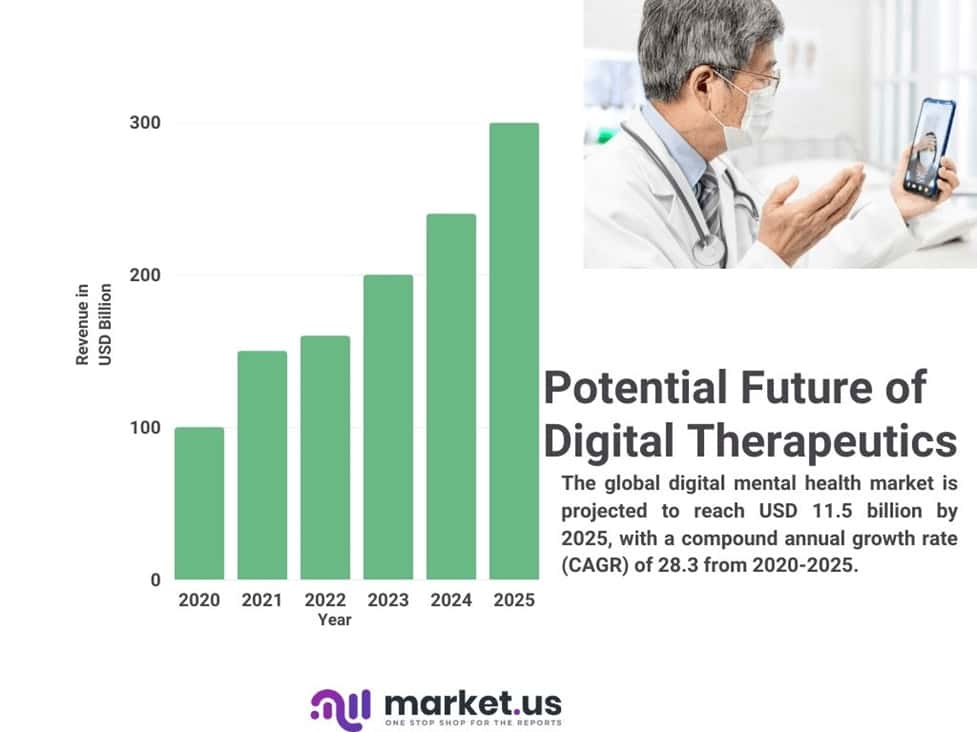
- The global digital mental health market is projected to reach USD 11.5 billion by 2025. With a compound annual growth rate (CAGR) of 28.3% from 2020-2025.
- It was found that 91% of patients with depression who used digital therapeutics reported improvement in their symptoms.
- About 79% of behavioral health organizations increased their use of telehealth during the pandemic.
- Digital therapeutics have shown promise in cardiac rehabilitation. A randomized controlled trial published in JAMA Cardiology found that digital therapeutics for cardiac habitation led to a 40% increase in adherence compared to traditional habitation programs.
(Source: Deloitte, Journal of Medical Internet Research, National Council for Behavioral Health)
Recent Developments
Acquisitions and Mergers:
- HealthTech Inc. acquired DigitalWellbeing Solutions for $300 million, expanding its presence in the digital therapeutics market and broadening its portfolio of digital health solutions.
- TherapeuticTech merged with WellnessDigital, forming a strategic partnership to combine their expertise in digital therapeutics development and behavioral health interventions. With combined annual revenues projected to exceed $600 million.
New Product Launches:
- MindFit launched a digital therapeutic app for mental health management, offering cognitive behavioral therapy (CBT) modules and mindfulness exercises, aiming to reach 1 million downloads within the first year.
- PainEase introduced a digital pain management platform utilizing virtual reality (VR) technology and biofeedback techniques, targeting 500,000 users within six months.
Funding Rounds:
- TherapeuticTech received $50 million in Series B funding led by Healthcare Investment Group XYZ to expand their digital therapeutics platform and invest in clinical trials for new therapeutic indications, aiming for a 50% increase in revenue within two years.
- WellnessDigital secured $30 million in venture capital funding from Tech Investors ABC to enhance their digital health platform and develop personalized therapeutic interventions, targeting a 40% growth in user engagement.
Consumer Trends:
- Rising awareness of digital health solutions fueled the adoption of digital therapeutics, with downloads of therapeutic apps increasing by 30% compared to the previous year.
- Teletherapy sessions surged during the COVID-19 pandemic, with a 50% increase in virtual therapy consultations and digital therapeutic interventions, reflecting growing acceptance of remote mental health care.
Regulatory Landscape:
- Regulatory agencies implemented guidelines for digital therapeutics approval and reimbursement, ensuring adherence to efficacy and safety standards in digital health interventions.
Investment in Research and Development:
- Pharmaceutical companies and technology firms allocated substantial resources to digital therapeutics research and development. With an estimated $4 billion invested globally in digital health technology advancements and market expansion initiatives.
Wrap Up
Digital Therapeutics Statistics – Digital therapeutics (DTx) is an emerging field in healthcare that offers promising solutions for various medical conditions.
The global market for digital therapeutics is growing rapidly due to the increasing prevalence of chronic diseases, rising healthcare costs, and advancements in technology.
The COVID-19 pandemic has accelerated the adoption of telehealth and virtual care technologies. Creating new growth opportunities for the integration of digital therapeutics into healthcare systems.
However, there are several challenges in digital therapeutics such as regulatory approval processes. Reimbursement models, data privacy, and security concerns, ensuring high user engagement and adherence.
Despite these challenges, digital therapeutics have potential in various areas such as behavioral change, medication adherence, sleep disorders, and mental health.
Lastly, digital therapeutics have the potential to transform healthcare delivery. Improve patient outcomes, and address the growing burden of chronic diseases.
Continued innovations, collaboration, and regulatory support will be crucial in realizing the potential of digital therapeutics in improving the healthcare industry globally.
FAQs
Digital therapeutics, also known as DTx, are software-based interventions that aim to prevent, manage, or treat medical conditions. They typically deliver therapeutic interventions through digital devices such as smartphones, tablets, or computers.
According to market.us, the global market for digital therapeutics was worth USD 4,530 million in 2021. It is expected to grow at a 24.2% CAGR from 2022 to 2032.
Digital therapeutics offer several advantages, including accessibility, convenience, and scalability. They can be easily accessed from home, reduce the need for in-person visits, provide personalized treatment plans, offer real-time monitoring and feedback, and have the potential to reach a large number of individuals at a lower cost.
Yes, healthcare professionals can prescribe digital therapeutics to their patients. In some cases, the healthcare provider may need to assess the patient’s condition and determine if a particular digital therapeutic is suitable for their needs. Prescription and monitoring of digital therapeutics are typically integrated into the overall treatment plan.
Discuss your needs with our analyst
Please share your requirements with more details so our analyst can check if they can solve your problem(s)



